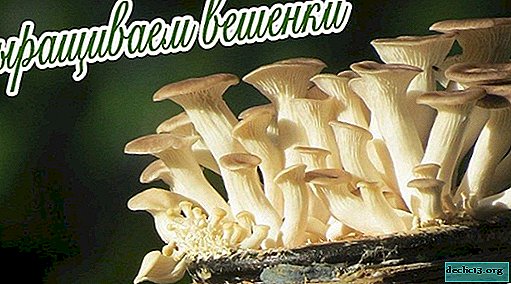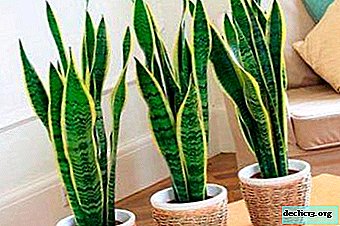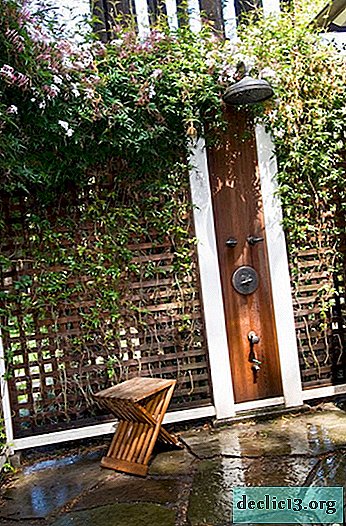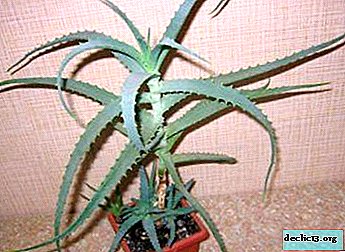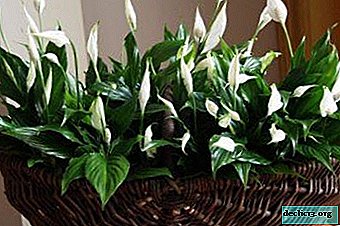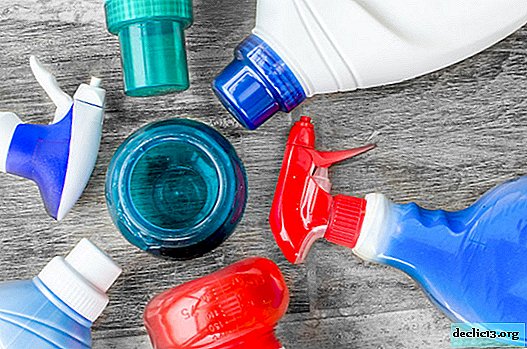What does the mealybug look and how dangerous? Pest Management Methods
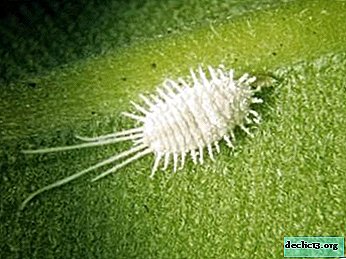
Mealybug is a sucking pest that has damaged many garden and indoor plants.
This is the common name of the family, which includes about 2200 species. Depending on the species, the insects of this family affect not only technical and fruit crops, but also greenhouse and ornamental plants.
Further in the article you will find visual photos of this pest and learn how to deal with it effectively.
What are these pests of indoor plants?
People call them shaggy lice. Females and larvae have a mouth sucking apparatus. They feed on the juice of shoots, buds and leaves, some species live on rhizomes.Sucking insects destroy plants, sucking out vital mineral and protein compounds. Damage to gardeners and gardeners is the result of their appearance.
More about what a mealybug is and how to deal with it on indoor plants, read in a separate article.
How they look: description and photo
Depending on the species, the body of the worm can be from 0.5 to 10 mm. Males and females outwardly differ. The male has an external resemblance to a mosquito and is covered with a white waxy coating. On the back of the abdomen there are long tail threads.
Wings, as a rule, are represented only by the first pair. Adult males do not have a mouthpart. The body of the females is oval, its coating resembles a powdery powder. The head, chest, and abdomen are very pronounced.
The colonies of these insects are quite easy to recognize with the naked eye along the white wax threads that entangle parts of the plant. Besides, sign of defeat - honey dew. So they are called sugary secretions - excrement. A soot fungus subsequently settles on them.




Habitat
Warm and humid climate are ideal conditions for its existence. Therefore, insects are especially common in the tropics. But some species are well spread in the subtropics. Affected unrelated plants can be found both on the open ground, and in the greenhouse, and in the winter garden, and in flower pots.
On plants, the parasite chooses leaf sinuses, stems, petioles, and the reverse side of the leaf for life.Among insects, they can be considered long-livers. The average life cycle from the appearance of the larva to death is 3-5 months. In closed ground, up to 5 generations can change in a year.
Kinds
Bristly
The body of an adult female is about 3.5 mm, pink or orange, covered with white coating. Individuals have well-developed limbs and move quickly. Belong to live-bearing species.
Settled in colonies. They are quite easy to identify at breeding sites by characteristic lumps resembling cotton wool.
Most often hit:
- fuchsia;
- oleander;
- primrose;
- palm trees;
- ficuses;
- dracaena;
- Coleus
- cycad.

Grape
Males are rare. In females, a flattened, oval body. The color is yellow or brown, with a whitish powder through which the insides are visible. After wintering, eggs are laid in cracks in the bark of plants. The number of eggs reaches 40. After 2-3 weeks, larvae hatching, feeding on plant sap. Their growth lasts about 5 weeks.
The second generation that has appeared is already more gluttonous and prolific (up to 150 eggs in a clutch). The third generation is considered the most harmful. The species is most widespread in the southern regions.It develops mainly on:
- grapes;
- figs;
- citrus fruits;
- olives.

Seaside
Originally from South America, but has now taken root and is prevalent in temperate regions. Outwardly similar to a grapeworm, but distinguished by obligatory pronounced tail filaments and longer fibers around the body. Body color of females is tan.
The life cycle consists of the development of 3-4 age stages. Each generation is characterized by increased fecundity and harmfulness relative to the previous one. From plants, prefers to eat juice:
- Tomatoes
- orchids
- pelargonium;
- laurel;
- cactus plants;
- begonias;
- asparagus.

Citrus
Female nymphs are 4-5 mm long., Body pink or crimson. The parasite affects primarily citrus fruits, grapes, boxwood, acacia, azalea, geranium, viburnum, camellia, tea bushes.

Harm
Damage insects inflict in many ways. Females and larvae, eating juice, deprive the plant of the substances necessary for life. In addition, physical damage is caused.Damaged leaves and stems turn yellow, fall off, and then the whole plant dies. Weakened plants cease to bloom and bear fruit, therefore, yields are reduced. Sugar secret of the vital activity of the parasite interferes with full-fledged photosynthesis and plant development.
The fungus that breeds in secret reduces the decorative value of the affected flowers. White strands of cocoons in which females lay their eggs can cover fruits and flowers, reducing their market value.
Is it dangerous to humans?
The insect parasitizes exclusively on plants. For humans, danger lies only in the effort, nerves and means spent on getting rid of the pest.
Reasons for the appearance
- An excess of nitrogen fertilizers.
- Increased air dryness.
- Soil overflow.
- Low temperature.
- Weakness of plants.
- Infection by indirect contact method. For example, larvae can be transferred on clothes from a diseased plant to a healthy one.
All of the above can be the result of the appearance of "shaggy lice." These are violations of the rules for the care of plants and their maintenance.
How to deal with a parasite?
 For the destruction of insects, there are chemical and folk remedies. Among insecticides, the most popular were:
For the destruction of insects, there are chemical and folk remedies. Among insecticides, the most popular were:
- "Aktara";
- Mospilan;
- Fitoverm.
Processing should begin in early spring and carried out strictly once a week.
Of the folk methods in the fight against the worm, recognition has earned:
- soap and alcohol spraying;
- infusion of garlic;
- broth of onion peel.
You can try several ways to find a more suitable one.
Preventative measures
- Systematic and thorough inspection of plants.
- Timely removal of dead leaves and shoots.
- Periodic washing of plants, especially the favorite places of parasites: leaves and their sinuses, young shoots.
- Compliance with the dosage when using nitrogen fertilizers. The probability of infection in soil rich in nitrogen increases several times.
- Quarantine of plants on which the initial foci of settlement were identified.
- Catching males. They fly to the light sources at night. For traps, you can use sticky plates fixed near the lamps.
To save your landings and prevent losses, it is necessary to observe a whole range of measures for proper care of plants. If the worm has appeared, it is necessary to quickly and accurately determine the extent of the lesion, and then proceed with actions to destroy it.
Useful video
We offer you to watch an interesting video about the mealybug:


